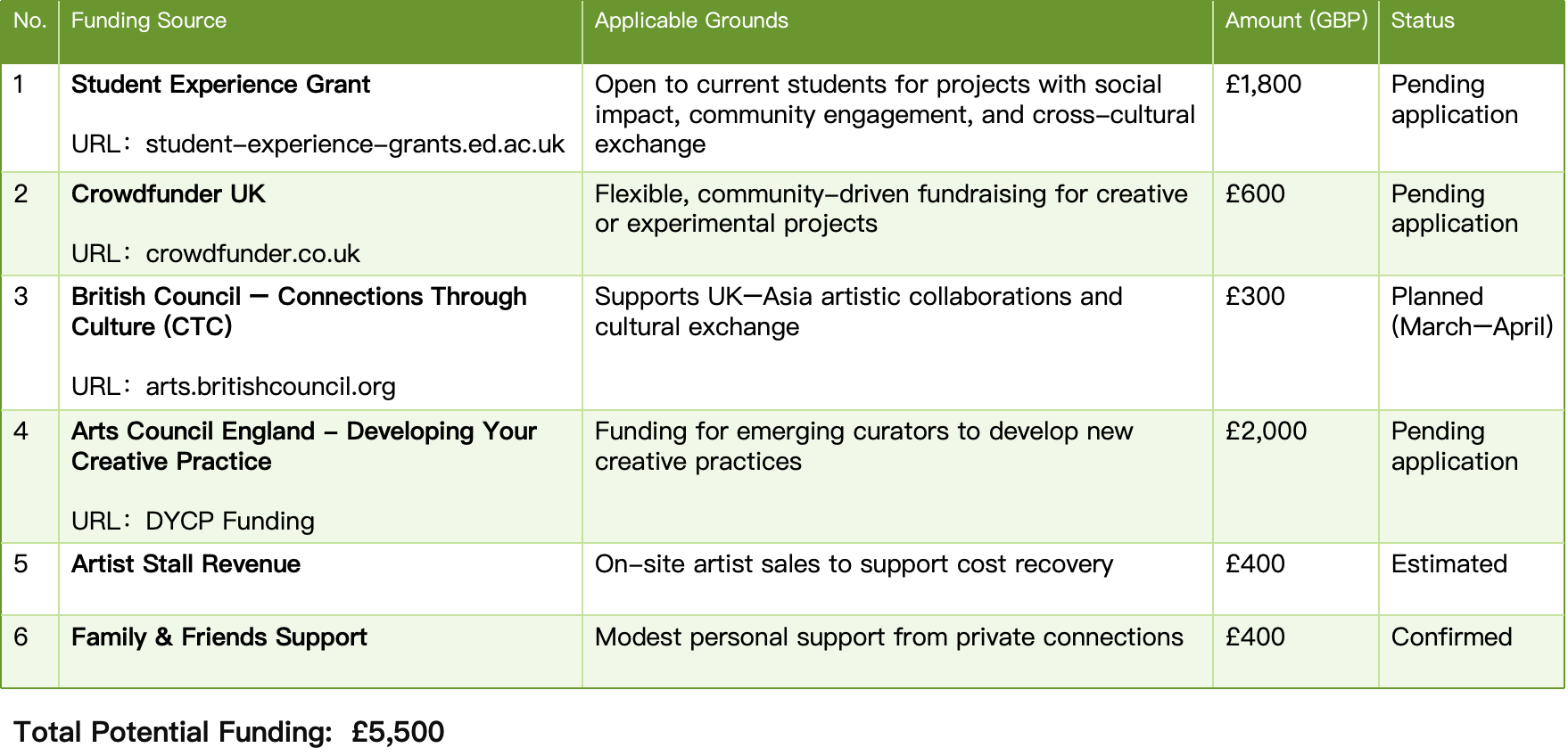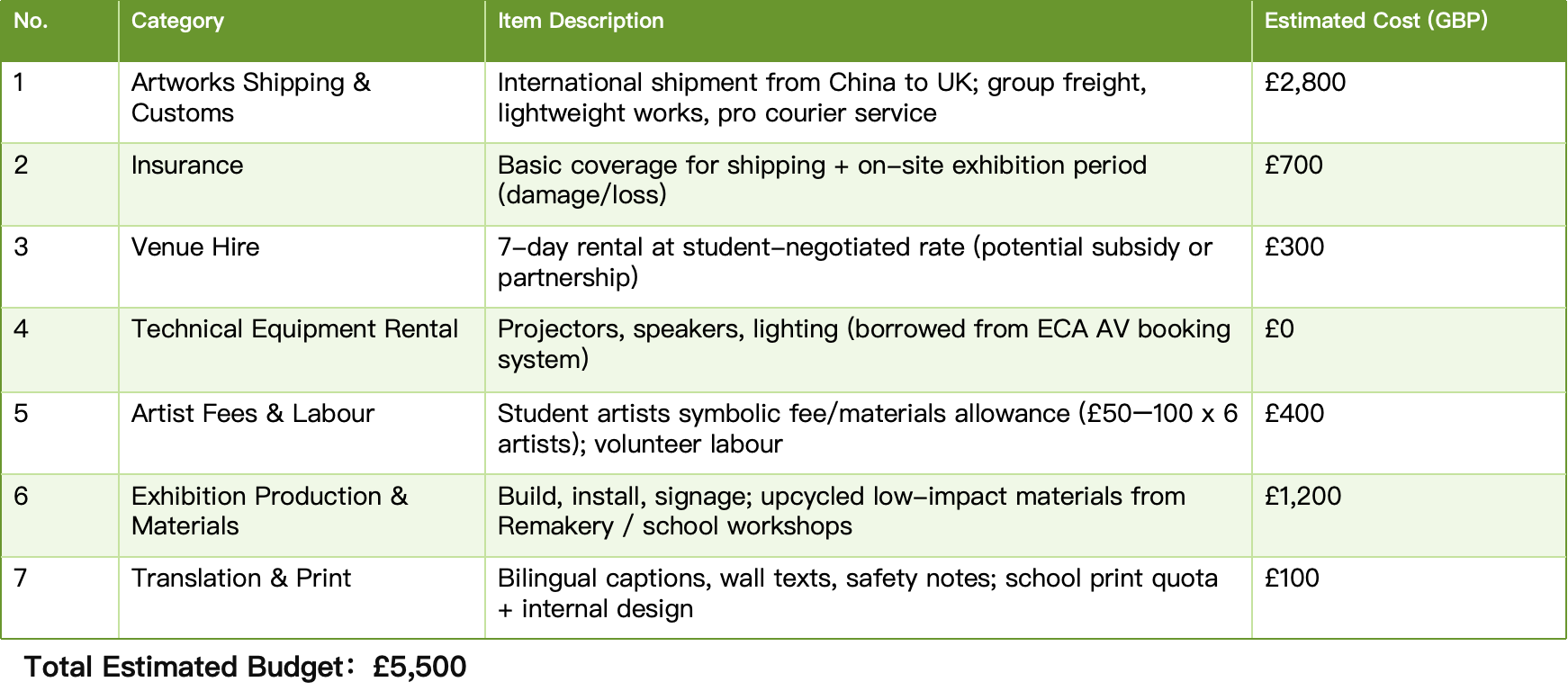Exhibition Duration: 7 Days
Venue: The Biscuit Factory, Edinburgh
Income:

Expenditure:

budget table © 2025 by Chuni Mao is licensed under CC BY-SA 4.0

30 March 2025
Exhibition Duration: 7 Days
Venue: The Biscuit Factory, Edinburgh
Income:

Expenditure:

budget table © 2025 by Chuni Mao is licensed under CC BY-SA 4.0
Julie Louise Bacon
3 April 2025 — 13:34
Overall, there is great deal of content on your Blog Chuni, you are clearly investing in the coursework, well done. The week 8 Collective meeting contains some strong detailed summaries of process, good work. Avoid re-using numbers in headings and sub-headings multiple times, aim to standardise sub-headings as much as possible, while making sense. ? There is a need not to just describe the Collective process but to critically evaluate this kind of discursive/collaborative process with resources, eg from Adam B/ week on Publishing where he discussed collective goals in detail: this relates to Learning outcome 2 and 3. You list at the end “feasibility of funding and exhibition space, change of artist selection” these are further areas where you could add research references from sector organisations/peak agencies, as discussed yesterday, relating to challenges in the sector with space and funding for example, to give context to your content. In the next post, you note that “‘life’s plasticity’ is not common in art: it depends on how you are looking at this, I would say a vast amount of art is connected with this in varying degrees, but break it down to what you mean, a set of criteria, and also supporting inspirational/critical/curatorial views on this. Plasticity can mean change, so much art is about change! As discussed in the group, you as a curator need to shape art’s meaning not look for example for the word ‘plasticity’ in a literal description of a work. The section on AR invites the research I stress is essential: add links on curatorial discussion of this, exhibition research examples, and perhaps writers on art and new technology. The final part ‘Reflection on the collective curatorial’ could arguably fit better in the previous post? It’s very good to see your fieldwork report of the Biscuit factory. You must attribute all images for information purposes and give sources/copyright. You compare the space’s advantages, consider better sub-headings a pros and cons. Also, when you compare it to other spaces you could establish a clearer set of criteria (Tate is formerly an industrial space but a totally different type of institution), or perhaps design and add a table of info to summarise? There is some good artist research in Week 8, well done, consider giving short standard length/format summaries for each post. Eg here ‘In this post, I explore x number of artists from around the UK, then name them and their medium and ?
The report on Marcus Week 8 lecture is thoughtful, and you identify ‘light, shadow, video, sound and other elements to give the exhibition a ‘temporality’’ as clear areas of focus in your own SICP. You go on to elaborate on two artworks, but it’s confusing whether the second one is titled Dreaming or Burning Woman’. It would be good to come to a thrid section in this post on your project, and connect it up with the artist research you posted previously: how is this connected, how is it asking new questions in your space/selection/layout? In Week 9 you do not engage with the lecture content, but do discuss your own thinking on publishing: this creates an unevent feeling when compared with your approach to Week 8, like something is missing. There is not as much research underpinning this post, no case studies as previously, not quotes from key ideas/texts idea from the course or your own research. The artist research in Week 9 is engaging, well done, however you do not link it back to any previous questions/reflections you have made on types of work, temporality, materials etc so it feels not joined up. It’s interesting to read your organisation of the curatorial space in themes, but they are a bit confusing, how do the 2 sets of headings relate ‘‘External Shaping – Internalisation – Symbiosis’. Man and nature (the role of the environment) Emotional well-being (individual experience) Immersion (empathy and rebirth). You also refer to ‘Finding Yourself’ but this is not listed? The fieldwork visit to Biscuit factory gives you very good documentation and information on the space, good to see. It would helpful to join ths up with previous thoughts on artist selection, and also to see your reflection on immersion and linear/journey exhibition design contextualised with curatorial research texts. There is no real focus on audiences or the mission and situation of your venue, and this in relation to artist-run spaces, SVAOs, multi-arts spaces and the modes of curating Terry Smith outlines in Week 2 text, for example. Your discussion of the Collective presents some useful summary information, and commentary, and is clearly organised, good. There is a need however not to just describe the Collective process but to critically evaluate this kind of discursive/collaborative process with resources, eg from Adam B/ week on Publishing where he discussed collective goals in detail: this relates to Learning outcome 2 and 3. You return in Week 11 to artistic content development, but don’t introduce this in any way to give context for where it sits in the overall process, how many artists are fixed, how does it connect to previous discussion in posts? You introduce AR in a post in a general way, then in a later post, give a very heavy academic analysis that has lots of great content, but feels disjointed because you have a very general then highly essay-life commentary. The goal is to establish and link specific practical and conceptual concerns in your project with examples of discussion then also practice. The budget is advancing, but please list only in English for clarity. Add links and discussion to develop the section on funding.